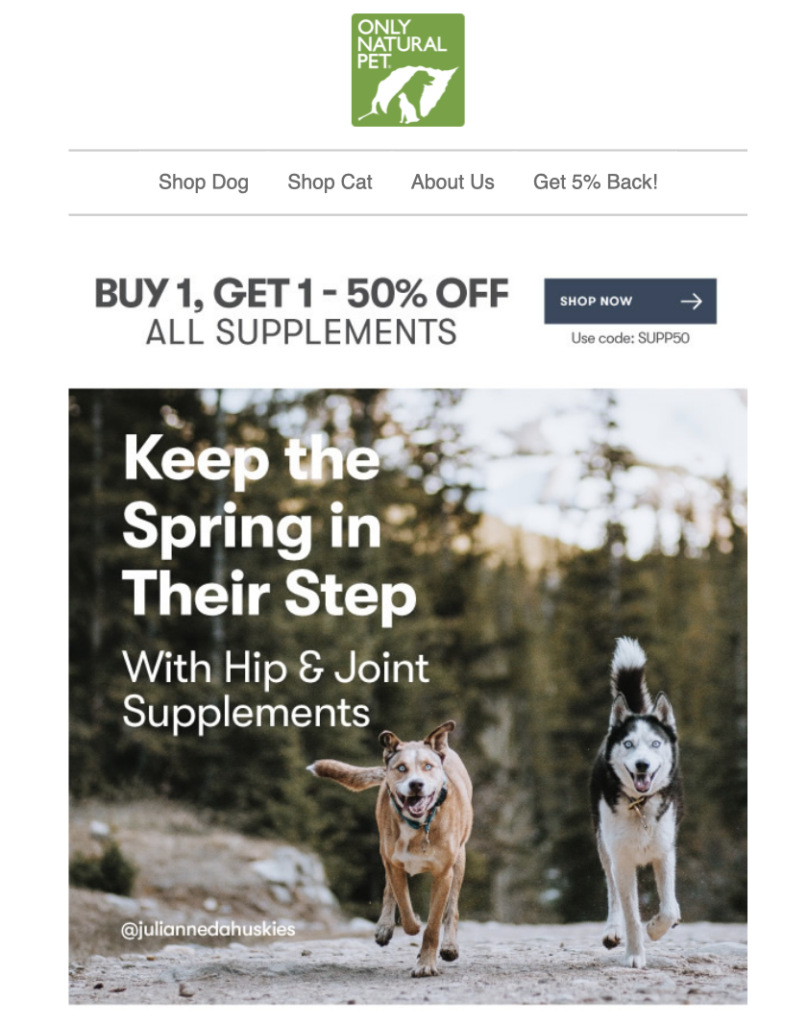
Your small business could be missing out on a huge revenue stream if you don’t have an effective email program in place.
Small businesses can face unique challenges with their (typically) limited resources, but email marketing can deliver significant benefits and help unlock growth opportunities, at a fraction of the cost of other marketing channels.
The benefits make the initial investment well worth it. For some explanation on why you should build your email program and how tips to maximize the benefits of email, keep reading.
Benefits of email marketing for small businesses
Email is cost effective
If you’re a retail company with an online storefront, your email program should be paying for itself and more. Email is known for having a high ROI. Depending on the source, email ROI trends at $36-40 per $1 spent.
Find an email platform that works within your budget and list size, grow your list organically, figure out a design strategy that works within your resources, and you’re ready to start bringing in the money. (When ramping up your program, you may find you’ve outgrown your current ESP. For expert tips to migrate to a different one, check out this on-demand webinar.)
There can be an upfront cost if you’re starting from scratch, including hiring the right person to run your email program, but once it gets running you should see a solid ROI that makes the investment worthwhile.
Email helps build brand awareness
The best way to grow brand awareness quickly is by growing your email list. Common ways to build a list include offering a coupon for new subscribers or asking for opt-in information within a contest entry form. First–time subscribers might not know much about your brand. Even if they do, email is a great story-building tool to help subscribers connect more deeply with your brand.
When fostering this connection, make sure your marketing outreach answers the five Ws:
Who: Who started the company? Who is the team making things happen? Share your history, as well as who your brand is today and how you’re growing and evolving for the future.
What: What is your company all about? What are your best-known products? Sure, you can sell clothing, but what makes it better or different than any other retailer? Do you use a different material, do you focus on sustainability and/or comfort, or do you design for a specific audience? What makes your brand unique?
Where: Where are you located? Is there any story behind your location? Do you have multiple locations? If you’re running an online–only store, where are your products manufactured?
When: Explaining when your company started is one way to look at this question. You can also address when people can expect their products to arrive, or when they can see results from using a product. Time can be important in many ways.
How: Do you have an interesting story behind how your company got started? How about how your products are made or how designs are created?
When building brand awareness, you should refer back to ways of integrating your other digital channels and how they integrate with your email strategy. All of these channels have to work together to create a cohesive, memorable brand. Using specific colors, fonts, logos, graphics, tone, messaging, etc. is important to keep your branding clear and easily recognizable.
Email helps build and maintain relationships with loyal customers
Email is a great platform to nurture ongoing relationships with customers. When they subscribe to your list, they’re giving you direct access to connect with them. A loyalty program is just one way you can show how much you value them as customers by offering exclusive insights, deals, first looks, and rewards. (For 10 tips to build a loyalty program subscribers love, check out this blog.)
Email can also be a way to quickly get information out to your subscribers. Not everyone has, or thinks to check, a brand’s social channels for news. If you have to close your store down for an emergency, if there’s a disruption like a global pandemic and you want people to know what it means for your business, or if there’s a last-minute change to a promotional event, you can use the relationship you’ve fostered with your subscribers to reach them quickly.
Don’t wait until the last minute to build an email list and find a platform. The sooner you start growing your contact list, validating the addresses, and setting up your email infrastructure, the sooner you can start generating revenue from email.
Email helps support other marketing channels
Your digital channels should all work together—particularly for small businesses that might have smaller-sized audiences. Where one succeeds, they all succeed. You can promote contests on social media and give people an option to subscribe for email when they’re registering to win. You can also promote social channels in your newsletters with content areas that showcase how customers are using your products, which you can track with hashtags.
If their images are high quality, you can reach out to your customers and ask about featuring their pictures in your marketing efforts. Including their @ tag makes it a win-win in getting them more exposure as well, like Only Natural Pet does with their hero image:
A simple way to start the customer’s multi-channel exposure to your brand is to promote your social channels within your welcome or onboarding email series. There are so many other outreach channels to reach people, so if you only focus on email or only promote your business via social, you limit your exposure and ability to build your brand.
Invite subscribers to join your social community by sharing links to your Facebook page, Facebook groups, Instagram, TikTok, YouTube, and more. Tell them which hashtags to use, or even include them in a subject line or preheader. By giving them specific hashtags, you’re giving them guidance for how others will track the brand, as well as creating an easy way to see your subscriber’s posts.
Sharing graphics is another benefit to uniting your channels. If someone on the team creates an amazing graphic to share on Instagram, there’s no reason why it can’t also be used in an email. Subject lines from emails can be repurposed into captions on social as well. Teamwork truly does make the dream work.
Email makes it easy to test what works (and measure results)
Testing is a highly effective way to see what resonates with your audience, from subject lines to email content and promotions. With the ability to easily segment your list into a random A/B split or into specific segments, you can learn what works—and what doesn’t. You can also apply the findings to your other digital channels.
Here are a few key considerations when conducting email testing:
Tone: Test the tone that works for your brand. Will more people open and click with a subject line such as “New hoodies are on sale now” or do they respond better to “Hide from the world in your new hoodie”?
Call-to-action (CTA): Is your audience motivated to click through with the simple and direct “Shop Now” CTA? Or would your response rate increase if your CTA was “Get it while it’s hot” or “Check it out”? Your CTA is worth testing to determine which type of approach will increase click–through and conversion rates.
Creative: Do your emails feature people using your products or feature product standalone graphics? Is your email template a short postcard style or a longer grid layout? Are your email messages text heavy, image heavy, or a mix? As long as it’s aligned with your brand, test and try it all out!
There are plenty of ways to test new ideas on your audience. Just remember it’s best to measure the results if you focus on testing one thing at a time. Use these results to help you build your brand style guide to keep everything streamlined. Learn more about email testing.
Pitfalls of email marketing for small businesses
Email has numerous benefits for small businesses. But, no marketing channel is perfect.
Pitfalls of email marketing might include:
Not communicating with other teams who send email
This might include duplicating efforts with your customer communications team, for example, which might result in subscribers having a bad email experience. Communication is key! Keep the discussion open between all teams that touch email. It’s important to remember that customers could also be receiving transactional or triggered emails from other teams in addition to the promotional messages you’re sending. Don’t duplicate or send contradictory messaging. Know how many emails are sent to customers, and be aware of specific days and times messages are sent to avoid overlap. Work with the other teams to make sure branding is consistent as well.
Investing in the wrong technology (or no technology)
As mentioned earlier, there is an upfront investment in building a strong email program. Take time to research and have demos with multiple small service providers to make sure you select one that fits your goals, functionality needs, service expectations, and budget. You also need to work with your IT team to confirm that the ESP will integrate with your website, since that is key to your ROI. You can also investigate AI to help you generate email content if that’s an area you struggle with. There are many tools out there that can help you build a strong email program.
Not tracking ROI from email
It is critical to track your operating costs and technology used, and to track your revenue from email. Keep an eye on revenue per email, revenue per campaign, revenue per segment, and more so you can quickly identify if there’s a performance drop in a specific area. Are your abandoned cart emails bringing in the majority of your revenue? Optimize that email stream further to support it while also identifying why people are abandoning carts instead of finishing their sales. Are you seeing a sudden drop in revenue per email? Clean your list, check your hard and soft bounce rates, and start testing different creative and send cadences. Track all metrics that you have visibility into so that you can continue to optimize and grow. Here’s a guide on key email metrics to track.
Conclusion
Email marketing isn’t just for large companies and major retailers. Small businesses can build email programs with high ROI and strong brand recognition. If your email program is still in early stages, gather your team, do some research, create a welcome series, and then grow your list.
You’ll start building relationships with subscribers quickly, and give your business a major marketing upgrade.
The email world is always evolving and changing, and new technologies constantly emerging. As you build your email empire, our State of Email webinar series makes it easy to stay up to date on the latest news and trends each month.
Register for our upcoming episode today!
